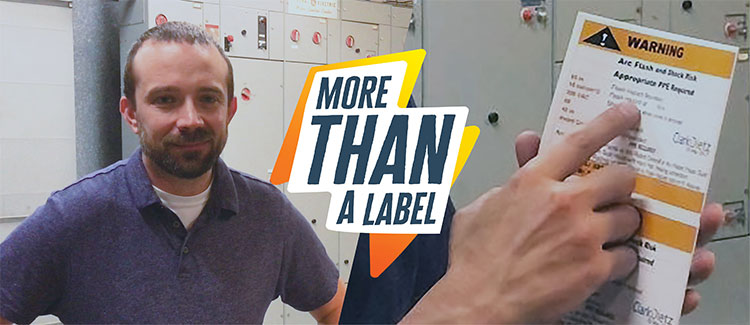Arc flash analysis is more than just a label. We interviewed Paul Zouski, PE to learn more about arc flash and how to protect yourself against potential hazards.
 What is your electrical background?
What is your electrical background?
I attended college at UW-Platteville, where I got my bachelor's degree in electrical engineering. After I graduated, I went to work for an electrical contractor for about ten years. When I first started, I had a lot of trouble understanding the means and methods of construction. I was talking to my boss, and we were trying to figure out how to make that better for me. We found a way to split my time between the office and the field working with the electricians. Because of that, I now have my master electrician license in addition to my professional engineer license.
 Can you demonstrate how to read an arc flash label?
Can you demonstrate how to read an arc flash label?
 Is an arc flash incident only a hazard for the person doing the electrical work?
Is an arc flash incident only a hazard for the person doing the electrical work?
No, not at all. That's one of the things we try to stress to people during educational events. Arc flash is a hazard to anybody that’s in the vicinity of electrical equipment while it's being worked on. Anyone who is within a certain distance, also known as the arc flash boundary, can be subject to a burn during an incident.
 Are you required to have a certain qualification to work around electrical equipment?
Are you required to have a certain qualification to work around electrical equipment?
That's kind of a tough question. There's a lot of dispute around that. The NFPA 70E states that only qualified people should work on electrical equipment. The definition of a qualified person is someone who has received training on how to operate and maintain a piece of equipment, and on the hazards associated with it. According to the National Electrical Code, you are considered a qualified person as long as you’ve obtained training on the specific equipment that you're working on.
 How do you know what level of protective gear to wear?
How do you know what level of protective gear to wear?

Ideally, your system will be labeled and have had an arc flash study performed. That little rectangular label will tell you the correct level of Personal Protective Equipment (PPE) incident energy of calories per centimeter squared. If you don't have that, there are tables that you can use as a guide in the NFPA 70E, but you need to be aware that there are some restrictions on those tables.
 What is the first thing that you look for when you're on a site?
What is the first thing that you look for when you're on a site?
When it comes to an arc flash study, we try to do some prep work before we get to the site, such as one-line diagrams for the system or utility information. If we can find out the fault current at the source before we get there, that'll help us prepare correctly with PPE. When we get on site, we always start at the beginning of the equipment where the utility comes in. This lets us get a good understanding of the size of the system, and where the different branches head to.
 What are additional things that you look for when doing an arc flash analysis?
What are additional things that you look for when doing an arc flash analysis?
What we do with the survey is try to be mindful of our surroundings. We're looking for basic things like code violations that deal with working space or grounding, for example. We look for various things so that we can let the owner know if there are any safety issues on their site.
 What constitutes a code violation?
What constitutes a code violation?
Several things can be a code violation. The most common ones that we see are working space violations. The National Electrical Code (Article 110) has specific rules about working space that’s required to keep workers safe. Grounding is where we also see a lot of issues. There are many rules with grounding that are often misapplied.
 How do you determine a hazard level?
How do you determine a hazard level?

A hazard level incident energy is determined through mathematical calculations. We take the available fault current from the utility, use that to determine the fault current at each point in the system, and then look at the fault current versus the clearing time of the breaker which is how long the fault would last. That's what determines what the incident energy is.
 How long does it take to complete an assessment?
How long does it take to complete an assessment?
It varies depending on the size of the facility. With smaller facilities, you’ve got a couple of days of survey, and building the model takes a while, as does the analysis. On the short end of things, a month. We’ve had larger studies that have taken six to eight months, but those are very large facilities.
 What is provided in an arc flash study?
What is provided in an arc flash study?
When we perform an arc flash study, we also do other things that are products of the study itself. We have to calculate the fault current at each point in the system, take that information, and compare it to the equipment fault current rating. Then we make sure that the equipment is suitable to withstand that fault current. That would constitute a short circuit study. We also do a coordination study on systems with adjustable breakers. This is to make sure that your settings match up so that all of your equipment is cascading properly. Labels are important. We provide a full set of labels for all the equipment we are going to study.
 Would you say that an arc flash analysis study is more accurate than just utilizing the NFPA 70E tables?
Would you say that an arc flash analysis study is more accurate than just utilizing the NFPA 70E tables?
A proper incident energy analysis is more accurate than the tables themselves. NFPA 70E has done a really good job of pointing out that the tables have very specific limitations. On every line, it'll tell you that the information on that line is only accurate for a certain amount of fault current and certain clearing time. The only way you have that information typically is to do a short circuit study and some of the other portions of the arc flash analysis that we do. It's not something you’re just going to know by looking at the equipment.
 Can anyone do an arc flash study?
Can anyone do an arc flash study?
It takes a well-trained set of electrical engineers to perform a study - someone who understands what the math is behind it and the basic concepts. Any of the software is only as good as the person putting the information into it and interpreting the information that the software provides.
 Would you say that there's an advantage to have an electrical engineer complete a study rather than a regular electrician?
Would you say that there's an advantage to have an electrical engineer complete a study rather than a regular electrician?
Generally, engineers have had more time to spend with the software. It's more of what we do. The software that we use is something that we use for other things besides just an arc flash study itself. We use it as part of our design process. So we're very familiar with the software, the limitations of it, and things to watch for when we run the study.
 Is there anything that an arc flash label does not show?
Is there anything that an arc flash label does not show?
An arc flash label is not going to tell you about the condition of the equipment. One of the safe work habits that NFPA 70E mentions is to be aware of your surroundings and understand the condition of the equipment. Equipment in poor condition is more likely to have an incident. An arc flash label is also not going to warn you about dangers that are inside, such as code violations. You still need to be mindful of your equipment. However, the arc flash label will give you the correct information so you can select the proper equipment to keep yourself safe.
 What sets Clark Dietz apart from other firms regarding arc flash analysis?
What sets Clark Dietz apart from other firms regarding arc flash analysis?
Clark Dietz, Inc. has been performing arc flash hazard analysis for a long time and is known for having a deep understanding of it. In fact, even before I started working here six years ago, arc flash was a big piece of the firm's work. We’ve done a lot of projects for different governmental agencies and private industry, both large and small.
Our staff of electrical engineers is usually working on an arc flash project. It's something that we understand well and do all the time. Everyone on our team has been trained on the software and has mastered its use. It's definitely not something we do on a one-off basis.





